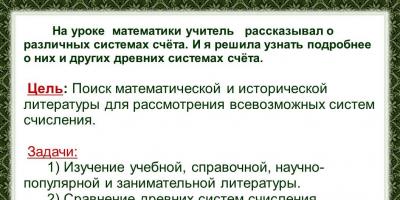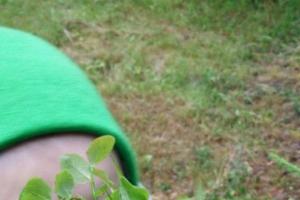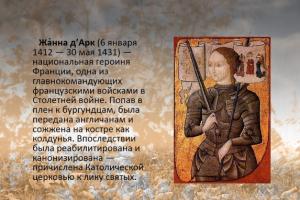Project topic
Forest life
Item
Ambient
world
Brief summary of the project
My project
on the theme "Forest Life". The goal of the project is to introduce students to
diversity of wildlife. They will reveal some signs of living beings to
environmental conditions and some relationships between them, will study some
species of animals and plants listed in the Red Book.
Planned learning outcomes
After
Upon completion of the project, students will acquire the following skills: Personal
will be formed: - a positive attitude and interest in studying nature;
-a sense of beauty based on acquaintance with the nature and culture of the native land;
can be formed: -sustained interest in studying nature; -skill
assess the difficulty of the proposed task; -adequate self-esteem; -feeling
responsibility for doing your part of the work when working in a group;
-conscious sustainable aesthetic preferences in the natural world; -basics
ecological culture. Students will learn to: -conduct independent observations
in nature and elementary experiments; record results; -explain what it is
natural community, give examples of signs of fitness of organisms
to living conditions in communities, some relationships between inhabitants
natural communities, the use of natural communities and activities for their
security; -characterize the features of the nature of your region; talk about
using the nature of your region and protecting it; -establish connections between
objects and natural phenomena; -follow the rules of behavior in nature. Students
will have the opportunity to learn: -give examples of plant adaptability
natural communities to living together; -explain some relationships in
nature, between nature and man; -evaluate the impact of activities
man to nature; -identify the reasons for positive and negative
changes in nature as a result of human economic activity and
behavior; -make basic forecasts of possible consequences of exposure
man to nature; participate in nature conservation activities. Regulatory
Students will learn to: -accept and maintain the goal of cognitive activity;
- plan your actions in accordance with the goal; -realize
step-by-step and final control; Students can learn: - independently
plan your actions in accordance with the goal; -on one's own
adequately evaluate the correctness of the task and make the necessary
adjustments. Cognitive. Students will learn: -find the necessary information
in the textbook and reference literature; -understand information presented in the form
text, diagram, table, diagram, plan, map; - carry out analysis of objects
nature, highlighting essential and non-essential features; -conduct
comparison and classification of natural objects according to given characteristics;
- establish cause-and-effect relationships of changes in nature; - highlight
essential information from educational and popular science texts. Students can
learn: -search for information using library resources and
Internet; -compare and classify natural objects independently
choosing grounds. - compare information presented in different forms,
generalize it and use it when completing tasks.
Questions guiding the project
What's happened
forest? What are the relationships between plants and animals in the forest? What does the forest give?
to a person? Why do plants and animals cry out to us, people, for help? What's happened
What plants grow in the forest? What animals live in the forest? Why in birch
Is it light in the forest? Why is there little light in the spruce forest? What connections exist between
plants and animals? Why should the forest be protected? What is the significance of forests in nature
and human life?
Project plan
The project begins with a discussion with students about questions
on the topic of the project For students and their
parents, the teacher offers a booklet explaining the use of project
methods for studying this topic, and containing problematic questions that
students will search for answers. Carrying out creative tasks on the topic of the project.
Students begin to document the results of their research. Assessment,
recent corrections, reflection on what worked and failed to do in
this project, what issues need to be discussed or disclosed in future
works. Protection of works. Students are preparing for the final conference. On
Teachers and parents are invited to the conference. Students defend their work
trying to answer the fundamental question
Presentation on the world around us" Life forests" (2 Class)
Info lesson › Primary classes ›Presentations›Presentation on the world around us" Life forests" (2 Class).Find material for any lesson by indicating your subject (category), class, textbook and topic
Infourok.ru > Presentation on
Project around the world ( 2 Class) on topic: Project "Life..."
Passport project. around the world around us. " Life forests" . 2012. Title project.1. Ivchenkova G.G., Potapova I.V. "The world, 2 Class» Astrel Publishing House LLC. 2011. 2. Elkina N.V. Tarabarina T.I. 1000 riddles.
Nsportal.ru > Environment Project
Presentation on topic: "Life forests Project Kobeleva Egor..."
Home School presentations 2 Class. Life forests Project Kobelev Egor, student 2 A class MKOU "NOSH 13" p. Bobrovsky Head Komelskikh M.G. - presentation. The presentation was published 4 years ago by the user Lyubov Chukina.
Myshared.ru > Presentation on the topic: "Life
Project "Life forests" 2 Class download
Slide captions: Life forests. Project Kobeleva Egor. student 2 A class. MCOU "NOSH No. 13" Bobrovsky village. Head Komelskikh M.G. Target project: Getting to know life forests, its inhabitants and its significance in life person.
Uchitelya.com > Project "Forest Life" 2nd grade
Life forests (2 Class) - presentation, report, project
Presentation on topic Life forests (2 Class). 48. 0:00 / 0:00. Quality Auto 1. Audio Subtitles. You can study and download the presentation report on topic Life forests (2 Class). Presentation for a given topic contains 22 slides. Use the player to watch...
Myslide.ru > Forest life (2nd grade) -
Life forests (2 Class) - presentation, report, project download
You can view and download the presentation on topic Life forests (2 Class). The report contains 22 slides. Presentations for any grade can be downloaded for free. If you liked the material and our presentation site Mypresentation, share it with...
Mypresentation.ru > Forest life (2nd grade) -
Presentation on topic "Life forests"on the surrounding world for...
Presentation Job on the subject "The World around us" on topic: "Life forests", addressed to primary schoolchildren classes and designed to tell them what role they play forests V life planets. Recommended for 2 -4 classes.
Pptcloud.ru > Presentation on the topic "Life
Project "Life forests" 2 Class- The world...
Educational projects. Project"School" 1st grade. Project "Life forests" 2 Class. In the tropical forest Microsoft Power Point presentation.
Sites.google.com > Project "Forest Life" 2nd grade -
project on topic life forests- SchoolKnowledge.com
Forest- place life life security forests, fighting poachers, caring for all forest inhabitants.
Znanija.com > project on the theme of forest life -
Project around the world LIFE FORESTS 2 Class- YouTube
Youtube.com > Environment Project
Presentation, report on topic Life forests (2 Class) - download
Presentation Life forests (2 Class). 26. 0:00 / 0:00. Quality Auto 1. Audio Subtitles. Here you can study and download the presentation for class on topic ABOUT project Academic subject: the world around us. Typology project: informational. Participants: students 2 class. Slide 5.
Presentacii.ru > Presentation, report at
Project on topic life forests- YourKnowledge.com
Forest- place life animals and birds, numerous insects, mushrooms, nuts, berries, medicinal plants grow in it. Many people devote their life security forests, fighting poachers, caring for all forest inhabitants. Thanks to their work, their responsibility...
Tvoiznaniya.com > Project on the theme of forest life -
Project around the world LIFE FORESTS 2 Class- YouTube
Youtube.com > Environment Project
Project By topic life forests 2 th class
Urokam.net > Project on the topic of forest life
Report on topic Life forests 2 , 4 Class world around message
Forest- this is a unique part of nature, a part of the land that is occupied by trees. Depending on the plants that grow there, forest It can be: tropical, subtropical, deciduous, coniferous and mixed. Forest not only trees inhabit, various animals live here...
Doklad-i-referat.ru > Report on the topic Forest Life 2,
Message-report Life forests 2 , 4 Class, the world
Message Life forests report. Forest predatory animals - foxes, wolves, lynxes eat meat. Alone, they hunt small rodents, but when they gather in packs, such as wolves, they can cope 2 , 4 Class, the world. Report on topic Life on the land surface forests.
More-dokladov.ru > Message-report Life
Life forests (2 Class) - presentation on the world around us
Presentation Life forests (2 Class). Forest is a whole world that is home to many different plants and living creatures. A detailed study of its features within the framework of the training project about the world around us is described on the pages of this presentation with...
Prezentacii.com > Forest life (2nd grade) -
Presentation on topic"Birds of our forests 2 Class" - download...
Inhabits large tall trees forests- spruce, pine. Prefers areas forests with rotting, dead and fallen trees, as well as those located next to old clearings with rotten stumps. The nest is usually made in hard-to-reach...
Ppt4web.ru > Presentation on the topic "Birds"
Project lesson on the world around us 2 class By topic...
Project lesson aimed at developing reading literacy in younger schoolchildren. Academic subject "The world around us" 2 Class. Subject lesson: “Trees forests" Goal: to develop in students the ability to extract information given explicitly.
Pedportal.net > Lesson project on
Subject project: « Forest- our friend"
3. Meaning forests V life forests. 5. Rules of conduct in forest Subject project Forest- our...
School19.tgl.ru > Project theme: “The forest is ours”
What gives us forest. | Country of Masters
Project on topic What does it give us? forest.Forest gives us mushrooms and berries: the strawberries were felted using the dry felting method, and the mushroom was molded from plastic. What a great fellow you are, Katyushka! My son and I (studying at 2 class) did it too project around the world around us, subject" life forests".But we are with him before...
Stranamasterov.ru > What does the forest give us? | A country
Subject project: « Forest- our friend"
3. Meaning forests V life of people. 4. Environmental disasters forests. 5. Rules of conduct in forest. 6. What is useful and what is harmful.1. Subject project is relevant for us. And the relevance did not arise suddenly. Maybe someone will say: “It’s corny.” We will call it for you - “ Forest- our...
School19.tgl.ru > Project theme: “The forest is ours”
Download Project Around the World Life Forests 2 Class mp3
What These People Found Changed Them Life Forever Top 5 Finds.mp3.Part 2 . repair of mini hydroelectric power station Autonomous life V forest Hydroelectric own hands.mp3.
Project goal: To cultivate a caring attitude and love for the native land; desire to take part in the conservation and protection of nature
To form students’ ideas about the forest as a natural community:
The idea of the project is “The forest is not only trees, but the plants and animals that live in it. Take care of the forest - our wealth!”
Download:
Preview:
Project passport
around the world
"Forest Life"
2012
Project name | "Forest Life" |
Primary school teacher Rafikova R.K. |
|
item | The world |
Class | |
type of project | Information (self-made product) and its public protection. |
by number of participants | individual |
by duration | medium duration (2 weeks) |
at the venue | extracurricular |
by number of items | mono project |
Objective of the project | To form students’ ideas about the forest as a natural community: To form ideas about the role of the forest in human life and its inhabitants. To cultivate a caring attitude and love for one’s native land; desire to take part in the conservation and protection of nature. |
Use of ICT | Creating custom presentations |
What competencies are formed and developed during the project? | General cultural, informational, educational and cognitive, communicative. |
Project stages |
||
stage | Student activities | Teacher activities |
Defining the project goal and name. | Introduction to the topic and purpose of the project. Understanding the problem. | Inform the topic and purpose of the project. Formulation of problematic issues. |
Project work. | Collection of materials. | Providing assistance in selecting the necessary sources of information. |
Presentation of results. Presentation | Presentation design | Assisting in the presentation of project results. |
Carrying out the project | Protecting your works. | Organizes the defense and summarizes the results. |
Equipment: interactive whiteboard, projector, posters depicting forests (coniferous, deciduous), crossword poster, student notes, presentations by students and teachers
" The forest is wealth and beauty, take care of your forests!"- proverb
Teacher presentation used
Project progress
Slide 1
"The house is open on all sides,
It is covered with a carved roof,
Come to the green house
You will see miracles in it." (Forest)
Today we will talk about the forest.
Slide 2
Hello forest. Dense forest,
Full of fairy tales and miracles!
What are you making noise about?
On a dark stormy night?
What are you whispering at dawn?
All in dew and silver?
Slide 3-5
Forests are different. Many songs and poems have been written about the beautiful birch tree, and the forest where birches grow is called birch forest or (birch forest).
What do we call the forest where spruce trees grow? (spruce forest) Pines? (Pine forest.) Oaks? (Dubrava.).
Both birch and oak forests are otherwise called... deciduous.
What do you think: what is a mixed forest? (A forest where different tree species grow nearby - pine, birch, aspen, spruce, cedar, etc.
(The project on mixed forests is presented by Emil Bikbaev)
So what kind of forests are there?
Deciduous coniferous mixed
A forest where coniferous trees predominate (spruce, cedar, pine) is called taiga.
A forest is not just a lot of trees. These are animals, birds, insects.
The project was prepared by Kuzyaeva Ramzia (report on insects)
Slide 6
Now let’s solve riddles and learn about animals:
Cunning cheat
red head,
The fluffy tail is beautiful!
And her name is………(fox)
White in winter, gray in summer.
(hare)
He's like a Christmas tree, covered in needles,
Deftly catches scary snakes.
And although he is very prickly,
Don't you dare offend him.
He lives in the forest, but he enters
And brave into the gardens……..(hedgehog).
The owner of the forest
Wakes up in the spring
And in winter, under the blizzard howl
He sleeps in a snow hut. ( Bear)
Gray, scary and toothy
Caused a commotion.
All the animals ran away.
Scared the animals...
(wolf )
Washes his food in the river,
To make it cleaner
Only then will it go into your mouth.
And that neat guy is...(raccoon)
The rope crawls along the ground,
Here is the tongue, the open mouth,
I'm ready to bite everyone,
It's because I...(snake )
His back is striped,
The tail is as light as feathers.
All the supplies are like in a chest,
Hides in hollows... ( chipmunk)
In rich clothes,
Yes, I'm a little blind,
Lives without a window
Haven't seen the sun.(mole)
Guessing a crossword puzzle (project prepared by Abaidullin Timur)
Horizontally: 1. What a red-haired cheat! He cleverly covers his tracks! 2. This bird can't sleep at night By morning the big-eyed huntress returns home. 3. Big, brown, shaggy. Clumsy, clubfooted. 4. Looking for acorns And scratch your back on a snag. Vertically: 1. He is long-legged and horned And they say about him: elk. 2. The four-legged snorts Small, prickly... 3. A gray predator walks through the forest. It terrifies hares. 4. This summer panty is gray. Well, when winter comes, he is white. The forest is insects. He is in the grass, his dear, Moved by the flower All four petals. I wanted to rip it off He took off and flew away ( BUTTERFLY ) The forest is birds. Yellow-breasted bird flying And the acrobat is wonderful. ( woodpecker) We’ll also watch a presentation about life in the forest (prepared by Batraeva Alsou) The forest is a world full of mysteries and secrets. Forest is the wealth of Russia. And how many different plants there are in it! In the summer we collect red and black currants, raspberries, blackberries and lingonberries in the forest. There are many different mushrooms in our forest. Many medicinal herbs grow in our forest: bearberry, burnet, yarrow, nettle, tansy, St. John's wort and many other plants.(Ivan-da-Marya, sorrel, chamomile) The forest is a green laboratory: it produces oxygen and traps gases and dust. The forest is a source of health; it is called the lungs of our planet. |
Slide 7-8 - Russia ranks first in the world in the number of forests. This is the enormous wealth of our country and our people protect and protect this wealth. The worst thing for our forests is fires. Forest fires destroy vast areas of forests. All forest fires occur due to some external cause, but most often due to human fault.
Students hand out handouts.
Causes of fires:
- an abandoned burning match, a cigarette butt;
- the hunter fired, the wad began to smolder and caught fire;
- people made fires in places with dry grass;
- spring fallen grass;
- economic work in the forest;
- a piece of glass focused the sun's rays like a lens and lit the dry grass;
- from short circuit of a high-voltage line;
- from a flash of lightning.
Reminders
Every person should know how to behave if they find themselves in a fire zone.
1. If a fire is just starting, it can be knocked down with green branches or covered with earth.
2. If the fire is severe, you must leave the dangerous place as quickly as possible and report the fire. You need to move away from the fire towards the wind along the roads, along the banks of a river or stream.
3. In case of strong smoke, cover your mouth and nose with a wet bandage-towel or clothing.
4. A safe place can be a field, the banks of a river or lake.
5. Children are not allowed to put out fires.
How to make a fire.
1. Children should not make a fire alone, without adults.
2. There should be no objects near the fire that could catch fire.
3. You cannot make a fire under trees.
4. Before lighting a fire, you need to prepare the fuel.
5. The fire must be built on an old fire pit.
6. If it is not there, then you need to remove the turf with a shovel and make a fire in the resulting hole.
7. You cannot light a fire with a lighter.
8. Be sure to watch the burning fire!
9. When leaving, you need to extinguish the fire: fill it with water or cover it with sand, and put the removed turf back in place.
Reminder - how to behave in the forest.
1. Children go to the forest only when accompanied by adults.
2. Only adults make a fire; they also cook dinner.
3. Children play only in the clearing; playing near a fire is dangerous.
4. In the forest, do not break branches, do not pick flowers, herbs,
5. Do not destroy bird nests, do not take chicks from the nest,
6. Be careful on the banks of streams and near lakes.
7. Clean up trash after yourself: burn paper on a fire, and put cans and bottles in trash boxes.
8. Fill the fire with water or cover it with sand.
9. Remember! After you, other people will rest in this place. Preserve the beauty of our forest!
List of used literature
1. Ivchenkova G.G., Potapova I.V. “The world around us, 2nd grade” Astrel Publishing House LLC. 2011
2. Elkina N.V. Tarabarina T.I. 1000 riddles. A popular guide for parents and teachers. – Yaroslavl: Development Academy,
4. Varley K., Miles L. Geography: Encyclopedia. M: Rosmen, 1994
Natalia Ivanova
from the series "Relax and Develop"
Even on vacation, a teacher cannot do without teaching. When we arrived at the Krupenino recreation center and saw a picturesque place in the forest near the lake, thoughts immediately appeared in my head to implement several environmental development projects for a child of four years of age.
The recreation center "Krupenino" is located in a real forest, where berries, nuts, mushrooms grow and hedgehogs, squirrels, moles and, of course, various birds live.
My baby and I walked along the health path in the forest every day. We got acquainted with the names of trees and berries. Be sure to consider poisonous berries and plants that do not need to be handled. We enjoyed picking strawberries and blueberries.
Relevance of the project: children of primary preschool age should firmly know the basic rules of behavior in the forest for the purpose of personal safety.
Integration of educational areas: cognitive development, speech development, physical development, artistic and aesthetic development.
Target: formation of primary skills of behavior in the forest, elementary ecological concepts
Tasks:
Tell and teach how to choose the necessary clothes for a walk in the forest;
Establish a rule for children - to go into the forest only when accompanied by adults;
Introduce the child to the names of some trees and berries.
Show dangerous plants;
Observe (if possible) the life of animals, birds, insects
Learn to admire the beauty of the forest, treat plants and animals with care;
Develop the child’s speech through the perception of short poems and fairy tales, as well as animated films on the topic of the project;
Develop drawing skills using various methods and materials;
Learn to collect natural materials for crafts;
Develop endurance when walking long distances.
Brief summary of the project:
Expanding a child’s horizons during daily walks in the forest: learning the names of healthy berries (strawberries, blueberries, raspberries, some trees (birch, oak, spruce, pine); observing insects, birds;
Formation of skills for carefully studying the forest - the ability to see nuts, mushrooms, notice flowers, mosses; listen to the singing of birds, the knocking of a woodpecker;
Organizing classes (including using cartoons) to study the rules of behavior in the forest (do not make noise, do not break branches, do not tear plants, be careful when picking berries, recognize poisonous plants - lily of the valley, wolf's bast, mushrooms, never take them into hands);
Introduce your child to the fairy tale “The Three Bears”; with short poems about trees, berries, mushrooms, forest animals (see appendix); cartoons “Eared Bear”, “Mole Painter”, “Strawberry Rain”;
Draw berries and mushrooms on the asphalt with crayons, naming their parts; during rain, draw on paper (wax crayons, watercolors) using the poking method using crumpled napkins;
Subject stickers: “Fir cones”, “Mushrooms for hedgehogs”, “Strawberries”, “Mushrooms under the leaves”;
Formation of elementary mathematical concepts (counting to 5, concepts narrow-wide, low-high, one-many)
Some photos of the project with comments:
Picking tasty and healthy berries





We collect medicinal herbs and natural materials







Learning to notice and observe





Admiring the beauty






Remember the names of some trees and shrubs




Forming bans









We fix the material








Thank you for attention!
The publication uses photographs from my personal archive.

PROJECT ON THE ENVIRONMENT 4th grade
FOREST LIFE
OBJECTIVE OF THE PROJECT:
increasing environmental literacy of students through the formation of ideas about the role of forests in the lives of humans and nature.

PROJECT OBJECTIVES:
introduce the features of the flora and fauna of forests;
identify environmental problems of the forest that have arisen due to human fault;
learn to apply knowledge in new conditions when creating a creative product - a book about the life of the forest;
develop the ability to recognize a problem and transform it into the goal of one’s own activities;
develop cognitive interest and activity, the ability to work with literature;
develop research skills;
learn to speak publicly and present your creative product.

THE PROJECT COVERS THE FOLLOWING EDUCATIONAL TOPICS ON THE ENVIRONMENT:"Forests of Russia"; "Forest and Man"; "Forest Life"
INDEPENDENT ACTIVITY OF STUDENTS: working with literature sources,
search for information and illustrated material,
looking at illustrations,
selection of illustrations for the text,
selection of illustrations and tests for the wall newspaper “Forest Life”.

ROLE OF THE TEACHER:
create conditions for the development of students’ cognitive and creative abilities,
accompany them in the process of project activities,
teach interaction with each other, with the teacher.

PREDICTED RESULT:
Creation
books "Forest Life"
creation of a wall newspaper “Forest Life”,
formation of research and creative forms of thinking,
development of cognitive abilities,
independent activity skills,
ability to speak publicly and present a project.

PROJECT DESCRIPTION Stage 1. PREPARATION
Lecture talk by Roman Gennadievich Golikov, an employee of the Pravdinsky Forestry Technical School, the purpose of which is to get acquainted with the flora and fauna of the Moscow region and its protection.

Writing an essay “The Life of the Forest” based on a conversation listened to in order to understand that the forest needs our protection.
Conducting a class hour on the topic “Visiting the Wise Book,” the purpose of which is to get acquainted with the history of the origin of the book and its components (this knowledge was useful to students when designing the book).

Conducting an extracurricular reading lesson on the topic “The forest is our best friend”, during which students became acquainted with the works of writers: A. Onegov “Corydalis”, G. Skrebitsky “In a forest clearing”, M. Prishvin “Birds under the snow” about the forest. During the conversation, it became clear that a person is not always fair to our mutual friend. By tracking the environmental problems of the forest, students outlined ways to solve them. One of them is the creation of a book and publication of a wall newspaper about the forest. So the problem was transformed into the goal of their activity. As a result, the students received homework to tell their parents about the creation of the book, seek advice on what material it might contain, and select material for a wall newspaper.

2nd stage. PLANNING
Collection of ideas and proposals for the release of a book.
As a result of the discussion, three groups were formed to conduct research and collect information:
- a group for collecting information about the animal world (illustrations, interesting facts);
- a group for collecting information about the plant world (illustrations, interesting veils);
- a group for collecting information about forest protection.

DISCUSSION OF THE COLLECTED MATERIAL
The 1st group talked about animals and came to the conclusion: put notes about animals and illustrations in the book, using the collected material.
The 2nd group talked about plants and suggested putting their material about plants in the book.
The 3rd group talked about the causes of fires and other disasters in the forest, as well as its protection and conservation.

INDEPENDENT WORK OF GROUPS
Students received homework to complete their work and prepare for the presentation.

3rd stage. PROTECTION OF RESULTS
Each group announced their results
The 1st group showed their material about animals.
. The 2nd group had information about plants prepared.
Group 3 talked about forest protection.

4th stage. REFLECTION
The groups assessed the work of each participant. The teacher assessed the work of the groups as a whole. The guys approached the preparation of their material creatively. Revealed the topic of your assignment. Interesting educational material was presented, in which there was a correspondence between the content and the illustrated material. And together with the creation of the book, we designed the wall newspaper “Forest Life”. The wall newspaper included interesting notes about the forest and illustrations for them.

6th stage. PROJECT RESULT
Students became acquainted with the peculiarities of the flora and fauna of forests, tried to understand the environmental problems of the forest, showed cognitive interest and activity in creating a book and wall newspaper, learned to speak publicly and present their creative product. Their work is assessed positively.

increasing environmental literacy of students through the formation of ideas about the role of forests in the lives of humans and nature.
introduce the features of the flora and fauna of forests;
identify environmental problems of the forest that have arisen due to human fault;
learn to apply knowledge in new conditions when creating a creative product - a book about the life of the forest;
develop the ability to recognize a problem and transform it into the goal of one’s own activities;
develop cognitive interest and activity, the ability to work with literature;
develop research skills;
learn to speak publicly and present your creative product.
THE PROJECT COVERS THE FOLLOWING EDUCATIONAL TOPICS ON THE ENVIRONMENT:"Forests of Russia"; "Forest and Man"; "Forest Life"
INDEPENDENT ACTIVITY OF STUDENTS: working with literature sources,
search for information and illustrated material,
looking at illustrations,
selection of illustrations for the text,
selection of illustrations and tests for the wall newspaper “Forest Life”.
create conditions for the development of students’ cognitive and creative abilities,
accompany them in the process of project activities,
teach interaction with each other, with the teacher.
Creation books "Forest Life"
creation of a wall newspaper “Forest Life”,
formation of research and creative forms of thinking,
development of cognitive abilities,
independent activity skills,
ability to speak publicly and present a project.
Lecture talk by Roman Gennadievich Golikov, an employee of the Pravdinsky Forestry Technical School, the purpose of which is to get acquainted with the flora and fauna of the Moscow region and its protection.
Writing an essay “The Life of the Forest” based on a conversation listened to in order to understand that the forest needs our protection.
Conducting a class hour on the topic “Visiting the Wise Book,” the purpose of which is to get acquainted with the history of the origin of the book and its components (this knowledge was useful to students when designing the book).
Conducting an extracurricular reading lesson on the topic “The forest is our best friend”, during which students became acquainted with the works of writers: A. Onegov “Corydalis”, G. Skrebitsky “In a forest clearing”, M. Prishvin “Birds under the snow” about the forest. During the conversation, it became clear that a person is not always fair to our mutual friend. By tracking the environmental problems of the forest, students outlined ways to solve them. One of them is the creation of a book and publication of a wall newspaper about the forest. So the problem was transformed into the goal of their activity. As a result, the students received homework to tell their parents about the creation of the book, seek advice on what material it might contain, and select material for a wall newspaper.
Collection of ideas and proposals for the release of a book.
As a result of the discussion, three groups were formed to conduct research and collect information:
- a group for collecting information about the animal world (illustrations, interesting facts);
- a group for collecting information about the plant world (illustrations, interesting veils);
- a group for collecting information about forest protection.
The 1st group talked about animals and came to the conclusion: put notes about animals and illustrations in the book, using the collected material.
The 2nd group talked about plants and suggested putting their material about plants in the book.
The 3rd group talked about the causes of fires and other disasters in the forest, as well as its protection and conservation.
Students received homework to complete their work and prepare for the presentation.
Each group announced their results
The 1st group showed their material about animals.
. The 2nd group had information about plants prepared.
Group 3 talked about forest protection.

4th stage. REFLECTION
The groups assessed the work of each participant. The teacher assessed the work of the groups as a whole. The guys approached the preparation of their material creatively. Revealed the topic of your assignment. Interesting educational material was presented, in which there was a correspondence between the content and the illustrated material. And together with the creation of the book, we designed the wall newspaper “Forest Life”. The wall newspaper included interesting notes about the forest and illustrations for them.

6th stage. PROJECT RESULT
Students became acquainted with the peculiarities of the flora and fauna of forests, tried to understand the environmental problems of the forest, showed cognitive interest and activity in creating a book and wall newspaper, learned to speak publicly and present their creative product. Their work is assessed positively.

The groups assessed the work of each participant. The teacher assessed the work of the groups as a whole. The guys approached the preparation of their material creatively. Revealed the topic of your assignment. Interesting educational material was presented, in which there was a correspondence between the content and the illustrated material. And together with the creation of the book, we designed the wall newspaper “Forest Life”. The wall newspaper included interesting notes about the forest and illustrations for them.








